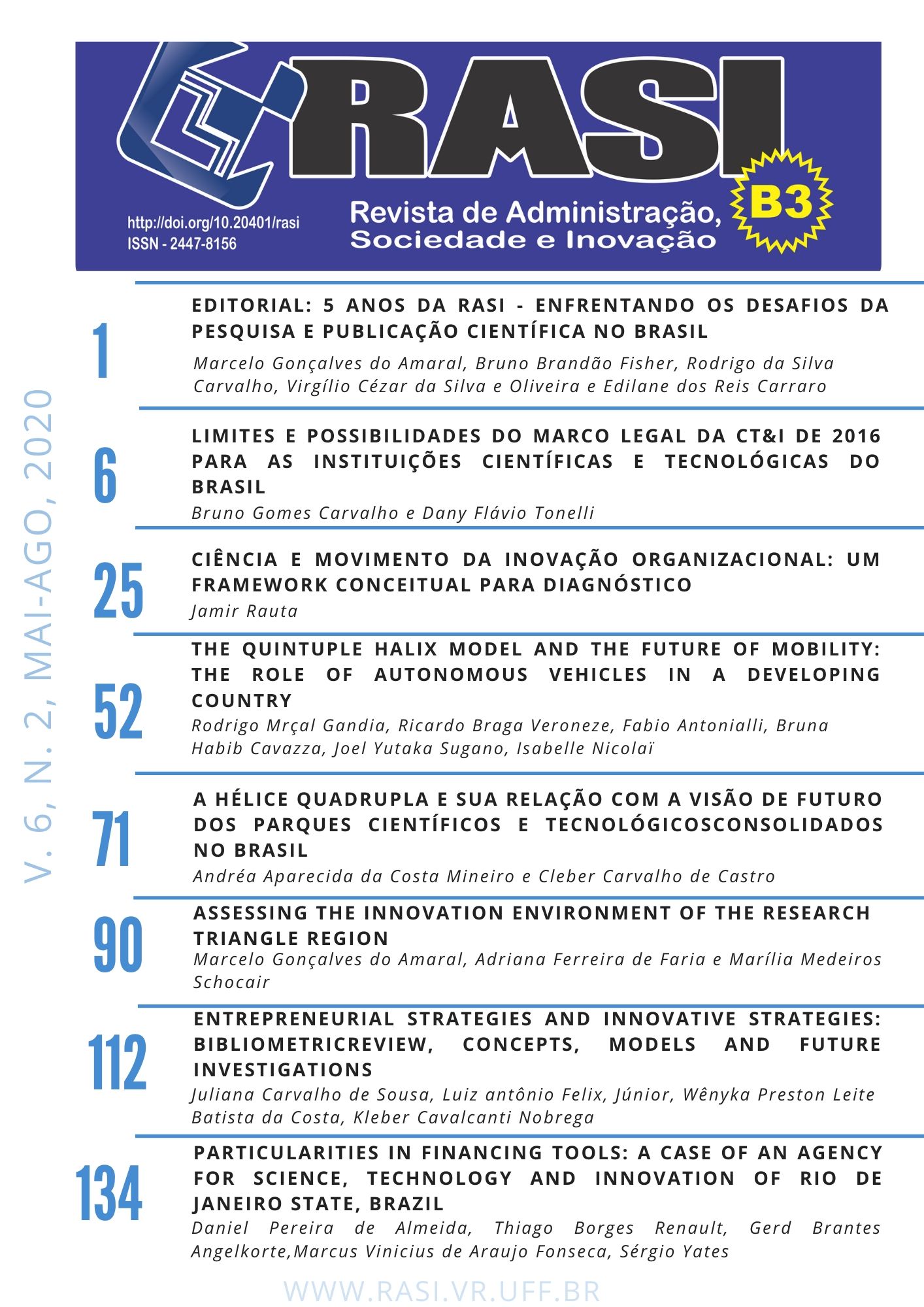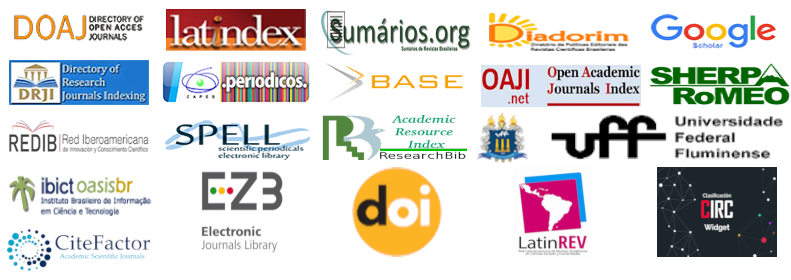Assessing The Innovation Environment Of The Research Triangle Region
DOI:
https://doi.org/10.20401/rasi.6.2.386Palavras-chave:
AMIEM, parques tecnológicos, triple helix, quintuple helix, RTPResumo
The paper studies the Research Triangle Region (RTR), an economic development area in the state of North Carolina, USA. RTR comprises two major technological parks: the Research Triangle Park and the Centennial Campus of North Carolina State University. We applied Amaral’s Model for Innovation Environment Management (AMIEM) to the RTR parks and discuss regional development aspects under the prism of innovation management and the model’s adequacy as a tool to assess complex environments. The research method is descriptive and exploratory. The field research, conducted during 2016 and 2017, involved a literature review, collection of documents, and non-structured interviews. AMIEM is a quantitative-qualitative model with eleven factors to measure the maturity level of the Triple Helix linkages from academia (knowledge producers), the productive sector of goods and services (knowledge producers and users) and government (social and economic regulator). The RTR parks have a high level of maturity. Several successful and overlapping initiatives were found there in the past sixty years which explain the regional development. AMIEM’s application is complex due to the number of actors, documents, and initiatives. It is a useful tool to assess innovation environments and technology transfer mechanisms, which fits the Triple and Quintuple Helix approaches.
Downloads
Referências
Amaral, M. (2015), “Management and assessment of innovation environments”, Triple Helix, 2:1-20.
ANPROTEC (2012), Estudo, Análise e Proposições sobre as Incubadoras de Empresas no Brasil – relatório técnico, ANPROTEC/MCTI, Brasília.
Bradley, S., Hayter, C., & Link, A. (2013), “Models and Methods of University Technology Transfer”, Department of Economics Working Paper Series 13-10, the University of North Carolina at Greensboro.
Becattini, G. (2002), “From Marshall’s to the Italian “Industrial Districts”, a Brief Critical Reconstruction”. In: Curzio, A. and Fortis, M., Complexity and Industrial Clusters, Springer, pp 83-106. Doi:10.1007/978-3-642-50007-7_6
Bush, V. (1945), Science, the Endless Frontier: a Report to the President. Washington: US Government Printing Office.
Katz, B., & Wagner, J. (2014), The Rise of Innovation Districts: A New Geography of Innovation in America, Brookings Institute.
Cabral, R., & Dahab, S. (1998), “Refining the Cabral-Dahab Science Park Management Paradigm”, International Journal of Technology Management, 16(8):813-818.
Carayannis, E.; Barth, T., & Campbell, D. (2014), “‘Mode 3’ and ‘Quadruple Helix’: Toward a 21st-century fractal innovation ecosystem”, International Journal of Technology Management, 46:3/4, 201-234.
Carayannis, E., Barth, T., & Campbell, D. (2012), “The Quintuple Helix innovation model: Global warming as a challenge and driver for innovation”, Journal of Innovation and Entrepreneurship, 1:2. Doi:10.1186/2192-5372-1-2.
Carayannis, E., Campbell, D., & Rehman, S. (2016), “Mode 3 knowledge production: systems and systems theory, clusters and networks”, Journal of Innovation and Entrepreneurship, 5:17. DOI:10.1186/s13731-016-0045-9.
Carayannis, E., & Campbell, D. (2014), “Developed democracies versus emerging autocracies: arts, democracy, and innovation in Quadruple Helix innovation systems”, Journal of Innovation and Entrepreneurship, 3, 12.
Carayannis, E., & Campbell, D. (2010), “Triple Helix, Quadruple Helix and Quintuple Helix and how do knowledge, innovation and the environment relate to each other?”, International Journal of Social Ecology and Sustainable Development, 1(1), 41-69.
Chesbrough, H. (2003), Open Innovation, Harvard Business School Press.
Collarino, R., & Torkomian, A. (2015), “Papel dos Parques Tecnológicos no Estímulo à Criação de Spin-Offs Acadêmicas”, Perspectivas em Gestão & Conhecimento, 5(2):201-225, Jul./dez, ISSN:2236-417X.
Correia, A. M., & Gomes, M. L. (2010), “Habitat Innovation Paqtcpb: Identifying Actions For Success”, Revista Gestão e Sociedade CEPEAD/UFMG, 4(8), Maio/Agosto. Doi:10.21171/ges.v4i8.897.
Etzkowitz, H. (2013), “Silicon Valley at risk? Sustainability of a global innovation icon: An Introduction to the Special Issue”, Social Science Information, 52(4):515-538. Doi:10.1177/0539018413501946
Etzkowitz, H. (2008), The Triple Helix: university-industry-government innovation in action, Routledge, New York.
Etzkowitz, H. (2002), MIT and the Rise of Entrepreneurial Science, London: Routledge.
Etzkowitz, H., & Leydesdorff, L. (2000), “The dynamics of innovation: from National Systems and “Mode 2” to a Triple Helix of university–industry–government relations”, Research Policy, 29(2):109-123. DOI:10.1016/S0048-7333(99)00055-4
Faria, A. F., & Kekas, D. (2016), “A research park as an engine for the Triple Helix Model of industry, government, and academic interactions: Centennial Campus’ Springboard Innovation Hub case study”, Proceedings of 2016 University-Industry Innovation Network Conference. UIIIN: Amsterdam.
Figlioli, A., & Porto, G. (2012), “Financiamento de Parques tecnológicos: Um Estudo Comparativo de Casos Brasileiros, Portugueses e Espanhóis”, R.Adm., 47(2):290-306. DOI:10.5700/rausp1040.
Freeman, C. (1995), “The “National System of Innovation” in Historical Perspective”, Cambridge Journal of Economics, 15:5-24.
Gibbons, M.; Limonges, C.; Nowotny, H.; Schartzman, S., & Trow, M. (1994), The New Production of Knowledge, Sage.
Ikenami, R., Garnica, L., & Ringer, N. (2016), “Innovation Ecosystems: An Analytical Approach of the Business Perspective For The Formulation of Interaction Strategies”, RACEF, 7(1):162-174. DOI:10.13059/racef.v7i1.232.
Henton, D., & Held, K. (2013), “The dynamics of Silicon Valley: Creative destruction and the evolution of the innovation habitat”, Social Science Information, 52(4):539-557. Doi:10.1177/0539018413497542
Hernández, M, (2015), “Ambientes innovadores en México: el caso del Corredor Industrial El Bajío”, Revista de Geografía Norte Grande, 62:203-221. Doi:10.4067/S0718-34022015000300012.
Jacoski, C.; Fontanela, C.; Pires, D.; Carlesso, L., & Hoss, R. (2015), “Regional development strategy - the case of the “Scientific and Technological Park Chapecó”, REBRAE, 8(3):356-370, Sept/Dec. Doi:10.7213/rebrae.08.003.AO06
Lastres, H. M., & Cassiolato, J. E. (2005), “Innovation systems and local productive arrangements: new strategies to promote the generation, acquisition, and diffusion of knowledge”, Innovation: Management, Policy & Practice, 7(2-3):172-187. Doi:10.5172/impp.2005.7.2-3.172
Lee, C. (2000), The Silicon Valley Edge: A Habitat for Innovation and Entrepreneurship, Stanford University Press, ISBN 9780804740623.
Leunga, C. K., & Wub, C. T. (1995), “Innovation Environment, R&D Linkages and Technology Development in Hong Kong”, Regional Studies, 29(6):533-546. DOI:10.1080/00343409512331349163
Leydesdorff, L. (2013), “Triple Helix of University-Industry-Government Relations”, in: Elias G. Carayannis (Ed.), Encyclopedia of Creativity, Innovation, and Entrepreneurship, New York: Springer, 1844-1851.
Leydesdorff, L. (2008), “Configurational Information as Potentially Negative Entropy: The Triple Helix Model”, Entropy 10(4):391-420.
Longhi, C. (1999), “Networks, Collective Learning and Technology Development in Innovative High Technology Regions: The Case of Sophia-Antipolis”, Regional Studies, 33(4):333-342.
Link, A. (1995), A Generosity of Spirit: The Early History of the Research Triangle Park. Research Triangle Foundation.
Link, A. (2002), From Seed to Harvest: The Growth of the Research Triangle Park, UNC Press.
Link, A., & Scott, J. (2003), “The growth of Research Triangle Park”, Small Business Economics, 20:167-175.
Lubik, S.; Garnsey, E.; Minshall, T. and Platts, K. (2013), “Value creation from the innovation environment: partnership strategies in university spin-outs”, R&D Management, 43(2):136-150. DOI:10.1111/radm.12006
Luger, M., & Goldstein, H. (1991), Technology in the Garden: Research Parks and Regional Economic Development, Chapel Hill.
Martinez-Cañas, R., & Ruíz-Palomino, P. (2011), “25 Years of Science Parks in Spain: Towards a New Model of Development”, Review of Business Information Systems, 15(5).
Mello, J. M., & Rocha, F. (2004), “Networking for regional innovation and economic growth: the Brazilian Petrópolis technopole”, International Journal Technology Management, 27(5):488-497.
Meszaros, P. (2004), “The History of North Carolina State University’s Centennial Campus”, Centennial Campus Documentation Project, NCSU Libraries.
Mineiro, A,; Silva, P.; Ottoboni, C., & Pasin, L. (2016), “Elements For Strengthening Local Innovation Network: A Case Study of Itajubá’s Innovation And Entrepreneurship System”, RACEF. 7(1):43-57. DOI:10.13059/racef.v7i1.183.
NCSU (2015), Results, XV, 2, Winter 2015/2016, Office of Research, Innovation and Economic Development, NCSU.
NCSU (2011), The Pathway to the Future. North Carolina State University Strategic Plan 2011-2020, Retrieved from http://info.ncsu.edu/strategic-planning/overview/pathway-to-the-future/
Nikina, A., & Piqué, J. (ed.) (2016), Areas of Innovation in a Global World: Concept and Practice, International Association of Science Parks and Areas of Innovation.
Porter, M. E. (1998), The Competitive Advantage of Nations, Free Press. ISBN:978-0684841472.
Rohe, W. (2011), The Research Triangle: From Tobacco Road to Global Prominence,University of Pennsylvania Press.
Research Triangle Region Partnership (2016), 2016 State of the Research Triangle Region. Report retrieved at http://www.researchtriangle.org/news-events/2016-state-of-the-region-event.
RTFNC (2015), Park Center Guiding Principles, Research Triangle Foundation of North Carolina, September.
RTFNC (2011). The Research Triangle Park - Master Plan, Research Triangle Foundation of North Carolina, November.
Saxenian, A. (1994), Regional Advantage: Culture and Competition in Silicon Valley and Route 128, Harvard University Press.
Schmidt, S., & Balestrin, A. (2015), “Brazilian Incubators and Science Parks’ Resources and R&D Collaboration”, J. Technol. Manag. Innov., 10(3). DOI:10.4067/S0718-27242015000300004
Svobodova, H., & Coupek, D. (2013), “Evaluation of Innovation Environment by View of High-Tech Entreprises: A Case Study of South Moravian Region”. In: Klimova, V.? Zitek, V. (ed). 16th International Colloquium on Regional Sciences, 174-181, Valtice, Czech Republic. DOI:10.5817/CZ.MUNI.P210-6257-2013-21.
Tornatzky, L., & Rideout, H. (2014), Innovation U 2.0 – Reinventing the University Roles in a Knowledge Economy, NCSU.
Varisa, M., & Littunena, H. (2012), “SMEs and Their Peripheral Innovation Environment: Reflections from a Finnish Case”, European Planning Studies, 20(4):47-582. DOI:10.1080/09654313.2012.665034
Vedovello, C. (1997), “Science parks and university-industry interaction: geographical proximity between the agents as a driving force”, Technovation, 17(9):491-531. Doi:10.1016/S0166-4972(97)00027-8
Wanga, S.; Fana, J.; Zhaoa, D., & Wanga, S. (2015), “Regional innovation environment and innovation efficiency: the Chinese case”, Technology Analysis & Strategic Management, 28(4):396-410. DOI:10.1080/09537325.2015.1095291
Downloads
Publicado
Edição
Seção
Licença
Copyright (c) 2020 Revista de Administração, Sociedade e Inovação

Este trabalho está licenciado sob uma licença Creative Commons Attribution 4.0 International License.
A RASI, de acordo com a Lei nº 9.610, de 19.02.98 que altera, atualiza e consolida a legislação sobre direitos autorais e dá outras providências, adota as seguintes condições da Cessão de Direitos Autorais:
- A Revista de Administração Sociedade e Inovação (RASI) mantém, com a cessão dos direitos autorais, a posse dos direitos sobre os conteúdos por ela publicados;
- O autor retém seus direitos morais do conteúdo, incluindo o direito de ser identificado como autor sempre que o conteúdo for publicado;
- Apesar da atribuição dos direitos autorais o autor retém o direito de reutilizar o material em coleções futuras de seu próprio trabalho sem ônus. Os reconhecimentos da publicação anterior na RASI são as únicas exigências em tais casos;
- O autor pode fazer fotocópias do conteúdo, ou distribuí-lo por meio de correio eletrônico ou fax, desde que destinadas às suas próprias aulas e com finalidade de atender objetivos de pesquisa, sob a condição de que: (a) tais cópias não sejam revendidas e (b) referência a fonte original da publicação e o nome da RASI estejam indicados claramente em todas as cópias feitas do material.











